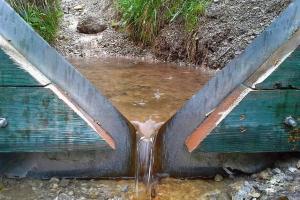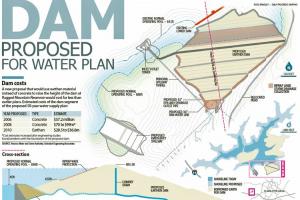Advantages and Disadvantages of Hydropower Plants

Hydropower is the most widely used renewable energy technology. It is a mature technology and its strengths and weaknesses are equally well understood. Advantages and disadvantages of hydropower schemes can be listed in terms of economic, social and environmental aspects.
Economic Aspects
Hydropower plants can provide peak load service. Their fast response times enable them to meet sudden fluctuations in demand and this improves electricity grid stability and reliability.
Production from hydropower .plants can start within just a few minutes while the time needed for other turbines are as much as 30 minutes. This feature, when combined with a storage capacity, offers a unique operational flexibility that can assist the development of other less flexible and less reliable renewable energy technologies such as wind and solar power.

Hydropower projects have a long life span of 50 to 100 years or more, unlike thermal plants having a lifetime of 25 to 30 years. Also operation and maintenance costs of hydropower plants are very low when compared to thermal plants.
Moreover, hydro power projects have the highest energy payback ratio among other electricity generation options . Energy payback ratio is the ratio of energy produced during the normal life span of a power plant divided by the energy required to build, maintain and operate it. As can be seen from Figure 15, energy payback ratio of hydro power plants with reservoir is around 200 while it is less than 10 for 27 coal and natural gas. The highest energy payback ratio belongs to run-of river plants, which is around 270.
Water is a domestic resource and hydro-power uses its energy without depleting it. Actually, this is the definition of ¡°renewable energy¡±. All hydropower plants, whether a run-of-river or a storage plant, meet this definition. Since water is a domestic resource, hydro-power provides independency in terms of energy and fosters energy security and price stability.
There would have been no need for thermal plants running with natural gas. If the price of 1000 m3 natural gas is assumed to be roughly $400, the saved import cost would be $8.6 billion. This scenario will result in dependency on foreign resources to decrease significantly.Another economic benefit of the hydropower plants is that some of the plants with reservoirs are used for water supply and irrigation purposes as well.
There are some disadvantages of hydro-power plants in economic terms. For large scale projects the most important economic disadvantage is the need for high upfront investment and long term planning. In this point of view, large hydro-power projects are not solely adequate as a complete solution in the short term. However, for small scale projects this disadvantage disappears.
Small hydropower plants, especially run-of river plants without storage are dependent on precipitation. In dry hydrologic seasons, small plants may not be able to generate the expected amount of electricity. This is one of the most important drawbacks of run-of river-plants. For hydropower plants with storage, however, hydrologic conditions do not have a pronounced effect, since these plants can store water in seasons of high flows and use it in dry seasons.
Another problem that may arise during the lifetime of a hydropower plant with storage is the decrease in storage capacity of its reservoir due to sedimentation. Moreover, alteration of sediment transport regimes could result in degradation at the downstream of dams. Magnitude of the degradation can sometimes be significant as in the case of Aswan High Dam on the Nile. The downstream of the dam was reported to be lowered by 2-3 meters in the years following the completion of the dam, leaving irrigation intakes high and dry and bridges being undermined. Further degradation is expected to be around 6-8 meters .However, sedimentation effect can be minimized through sediment management methods such as sediment routing, erosion control, sediment flushing and sediment removal by mechanical dredging or siphoning .
Social Aspects
Hydropower projects can have both positive and negative social impacts. According to IHA [3], hydropower has a huge potential for improving social justice, as long as projects are developed and managed in a way that enhances equity between:
- Present and future generations
- Local and regional communities
- Vulnerable social groups and society at large Nations
Equity between present and future generations is enhanced through the use of clean and renewable resources. Therefore, present generations do not deplete natural resources, saving them for future generations and maintaining a cleaner world by minimizing the use of fossil fuels.
Hydropower projects often provide flood control, supply water for domestic and agricultural uses, enhance navigation conditions and accessibility of the territory with access roads and bridges, and provide employment opportunities for the local communities. In many places, hydropower alone facilitated the social and economic development of societies. For example, development of the arid regions of the western USA has only been possible through the construction of dams and in Asia the so-called ¡°Green Revolution¡±, which has led to large increases in food production over the last 40 years, is to a large extend supported by dams .
Hydropower projects may have negative effects on local communities. Negative social impacts of hydropower projects are mainly associated with displacement of people living at and in the close vicinity of the dam and the reservoir area. For large projects, number of people forced to resettle reaches millions. For instance, more than 1.2 million people are relocated due to Three Gorges Dam in China although the reservoir area is typically regarded as a poor mountainous area with little development Even if the population to be relocated is not very high, serious
Social conflicts may appear. The San Juan Dam in Mexico was indefinitely postponed when confronted with a tough opposition from the local Indian population. The residents affected by the Chico River project in the Philippines joined the guerillas to stop the project .However, there is a growing awareness about the consequences of resettlement in the world. The countries suffering the most from these consequences in Asia and Latin America have developed comprehensive strategies for compensation and support for the affected people. Successful examples revealed the key concepts in resettlement actions as
- Timely and continuous communications between developers and those affected
- Adequate compensation, support and long term contact
- Efforts to ensure that the disruption of relocation is balanced by some benefits from the project.
One of the successful examples is Birecik Dam in the Southeastern Anatolia Region of Turkey. 30000 people were affected and 6500 of them were subject to resettlement due to the construction of the dam. In the planning and implementation process of the project, public awareness and participation were sought. Questionnaires and public meetings were arranged and the final shape of the plans was given under the guidance of public opinion. New settlement areas were chosen by the affected people. Besides the funds awarded to the ones affected, new income generating facilities like beekeeping and new crop types suitable to the region were introduced in order to compensate for the losses due to the dam construction. A Multi-Purpose Community Center (CATOM) was established in order to facilitate social adaptation to the new settlement area.
Another social impact of hydropower projects arise from the land requirements. Especially large projects with reservoirs can inundate fertile lands, and cultural heritages.
These negative impacts of hydropower projects are mostly related with large hydropower projects with reservoirs. Run-of-river plants do not require large areas. Actually, when compared to other energy options, a run-of river hydropower plant is one of the least land requiring options Therefore resettlement and land requirement problems are irrelevant for these types of projects.
Although run-of-river hydropower plants have relatively small impacts as compared to storage plants, they are also confronted with public opposition. Construction of access road, transmission lines and powerhouse can damage unique ecosystems. Moreover, these plants may negatively impact human activities such as fishing and ecotourism. Since water is diverted from its natural course, the locals who use the water for drinking or irrigation purposes may be affected. Some of them earn their living from the river and they may have to move their house in search of other jobs. Their lifestyle are altered and threatened.












